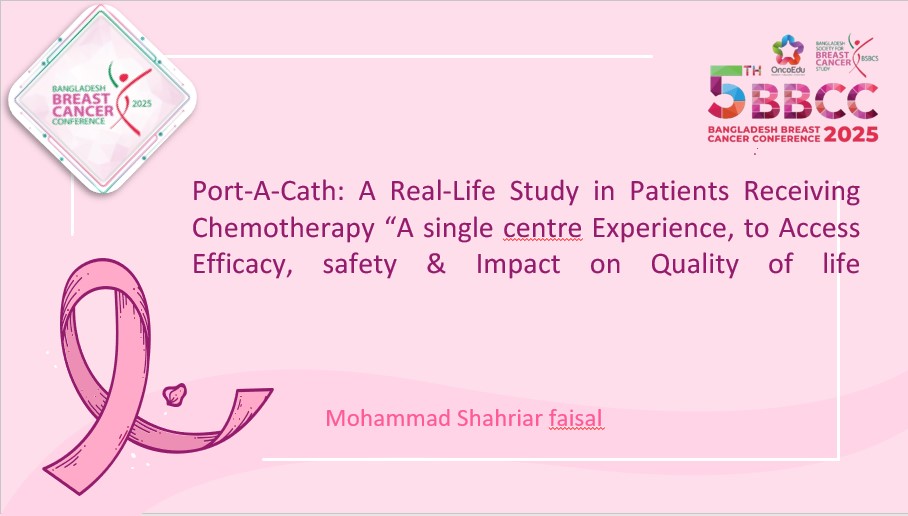Port-A-Cath : A Real Life Study in Patients Receiving Chemotherapy – Single Centre Experience, to Access Efficacy, Safety & Impact on Quality of Life
Authors: Dr. Mohammad Sahriar Faisal, Dr. Md. Arifur Rahman, Prof. Dr. Qamruzzaman Chowdhury, Dr. Ferdous Ara Begum, Dr. Ayasha Shiddika
Institution: 1. Dr. Mohammad Sahriar Faisal, Consultant, Department of Surgery, Bangladesh Specialized Hospital 2. Dr. MD Arifur Rahman, Consultant, Department of Oncology, Bangladesh Specialized Hospital 3. Prof
Introduction
Chemotherapy through Peripheral Venous Access (PVA) causes redness, swelling around the puncture site with multiple punctures, Pain or burning sensation at the injection site, streaking redness along the vein, phlebitis & extravasation. Meanwhile Port-A-Cath (PAC) provides significant benefits for cancer patients by offering easy, repeated access, minimizing discomfort & greater mobility while undergoing chemotherapy treatments. There is very little data in the world accessing experience of PAC in patients receiving chemotherapy & it is The First study in Bangladesh addressing this group. The purpose of this study is to assess the experience of patients with PAC who have h/o receiving chemotherapy with PVA, to evaluate any access related anxiety, pain or any complication related to venous access, to see the satisfaction, any restricted mobilities of daily living of patients receiving chemotherapy with PAC systems .
Methods
From 2019 to 2023, about 170 port cases were surveyed, where some patients died and others were not intrigued; on the other hand, a part of the population didn't experience chemotherapy through PVA. Finally, 54 port cases were chosen for this mixed cohort study on hospitals that had past experience with chemotherapy through PVA for their illness interaction at Bangladesh Specialized Hospital. Visual Analogue Scale (VAS) was utilized to get to pain and Modified Facial Anxiety Scale (M-FAS) to get to uneasiness. Experience during PVA and PAC was observed in the same patient population.
Results
Among 54 patients, M:F ratio 1 : 1.7, average age 39 yrs. Average cycle with PVA 4.23 ranging from 1-30 cycles, average duration of sticking to PVA was 2.5 months, average pain during access procedure with PVA 4 (ranges 2-6), Around 64% patient showed moderate anxiety. About complication during PVA process, one patient had extravasation, 33 patients had difficulty to access PVA due to phlebitis & 3-4 pricks per procedure & were dissatisfied with PVA, that is 64% had complication during PVA while 36% patient (21 patient) had to insert PAC for their continuous chemo purpose after several cycle & were satisfied with PVA. After inserting Port, Average cycle with PAC is 12 (ranges 3-30), average duration of PAC was 23 months (ranges from 3 months to 4 yrs), average Pain related to PAC process was 1.4 (ranges 1-6). About anxiety during PAC , 80% patient showed mild to no anxiety & 20% (11 patients) showed moderate anxiety during PAC process. Around 09% (05) patient showed complication during PAC- 3 had severe port site infection & port had to be removed, 1 had port catheter kinking & fixation was done, 1 had to reposited port for port site infection – all 5 patients inserted PAC in between chemotherapy. About psychological aspect, 92% patient were satisfied with PAC while only 36% with PVA. Considering mobility, 100% case had wide range of mobility during PAC procedure, while it was restricted for few hours during PVA procedure.
Conclusion
Port-A-Cath is a safe & effective option by avoiding chemotherapy related local complication with easy access & subjective comfort, especially for patients receiving chemotherapy, thus helps improving quality of life with access related less pain & anxiety with good patient compliance. With cost consideration port-a-cath can be advised with individual needs.
